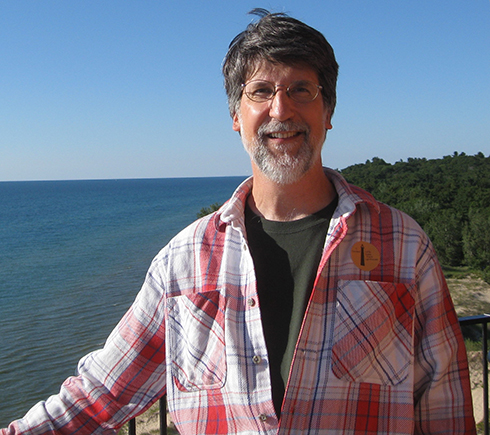Professor, College of Arts, Sciences and Education
by John Smith - Aug. 15, 2022
 Paul Klatt
Paul KlattHis instructional range runs from 100-level to 400-level coursework in biology. Still, as a bird behavioral ecologist, Professor Paul Klatt welcomes every opportunity to observe and build a greater understanding of winged creatures. That included several moments before the interview for this feature, as Klatt paused on his walk from the Science Building to the David L. Eisler Center (formerly, the University Center) to observe a bluebird inspecting the grounds and a nearby tree.
“I have always loved birds, even as a kid,” Klatt said. “I grew up in Illinois, with our home very near Black Hawk State Historic Site. It has a singing bird nature center, but when I was young, I would call to the Barred Owls, which were in the mature forests there.
My family also has property in the Upper Peninsula in Menominee County, which has always been a great place for examining birds.”
Though Klatt has an avocation for aviary life, he began his postsecondary education at the University of Illinois, where he earned a Bachelor of Science in Psychology.
“I saw my undergraduate studies as a way to further my interests in birds,” Klatt said. “A big part of my focus has been ‘What is that bird doing?’ My instructors at U of I Urbana-Champaign told me I should reach out to Eastern Kentucky, where I would have the best chance to pursue my intentions. That has allowed me to collaborate with some famous researchers in this field.”
One of Klatt’s earliest research pursuits focused on the coupling habits of Eastern Screech Owls, pursuing the idea that they seek out and nurture a single mate.
“I really loved working on paternity studies, which included researching how they vocalized to attract their mate,” Klatt said. “No one had applied this type of consideration to a bird of prey, but they have always held my interest.”
Other scholarly efforts that followed for Klatt focused on Red-Necked Grebes and Scarlet Tanagers.
“Over the years, I have researched concepts like the size of a particular bird’s territory,” Klatt said. “I am always excited to get into the woodlots, meadows or forests, to take up these studies and offer my findings in journal articles and other presentations.”
Klatt came to Ferris in 2005, offering a Biology class in Ornithology, among other aspects of science.
“I feel lucky that students are willing to embrace these subjects,” Klatt said. “One of the exercises that remain enjoyable for them is to ‘pish’ a bird by offering a scolding call that would be given at predators.
I adapted a technique I learned from a mentor at Eastern Kentucky, Gary Ritchison. He showed us how to mimic such a call for a Carolina Wren. The properly executed call draws the bird in, as they want to know if there is a risk. Students can succeed at this exercise when we take it out into the field, and that helps them to ignore whatever awkward feelings they have and give their best effort.”
Klatt notes that some students have a greater epiphany resulting from their time completing the Ornithology class, which brings them to newfound understanding and inspiration for their lives.
“A student of mine, Erika Dittmar, had come to Ferris with intentions of advancing on a Pre-Medicine degree,” Klatt said. “She found that the study of birds was her calling. Now, she is part of a nonprofit in Hawaii, working as a researcher and helping sea birds to maintain their population.”
Klatt added, “Not every student is looking for that catalyst in my class, and that is fine. It is very rewarding, though, to help those who are looking for their own niche to have that chance to consider, explore and then embark on that journey. I am fortunate to look back on Erika’s learning and career choice, seeing my small contribution to her pursuits and to be able to enjoy her success.”
One of Klatt’s efforts that has brought attention beyond the classroom and Ferris campus got its start in 2006, as he spotted an Osprey passing over the Rankin Center, the precursor to the University Center Building.
“When I saw it was carrying a stick, I broke into a run to keep an eye on it,” Klatt said. “I saw the osprey take the stick to the top of a light pole in a parking lot near the Swan Building. At that moment, I decided there needed to be a camera to observe, and display the development of our osprey.”
The idea was not as warmly received as Klatt hoped when he started on his journey to make the Osprey Cam a reality.
“People would ask, ‘Why put a camera up there?’” Klatt said. “I told them there was a Peregrine Falcon Camera when I was doing doctoral studies at North Dakota State, which was a real hit. I felt an Osprey Cam had the potential to be a real point of interest for the university community and beyond.”
In the months that followed, Klatt learned that the desire to establish this amenity and having the ability to bring it to be called for significant collaboration from all areas of the Ferris campus.
“I received so much help from the Welding program, Information Technology Services, telecommunications staff and the university’s Physical Plant operation,” Klatt said. “When I was making my first inquiries, the parking lot near Swan Building was seeing some infrastructure work below ground. A great deal of the work that allowed the Osprey Cam to go live was accomplished through the kindness of their hearts.
We also had to turn to the Office of General Counsel for assistance with state and federal permits. I am so glad there was interest in supporting my request and that it continues.”
Klatt said one of the realities the Osprey Cam has brought its viewers over the years is that not every situation on that high perch is a “Disney moment.”
“The osprey pair is not always able to bring every egg laid to become a baby bird, and not each one of their young successfully leaves the nest,” Klatt said. “All situations in the nest are shown in real-time.”
With more than a decade of service as a member of the Ferris faculty, Klatt has also chosen to accept duties that take him beyond the role of professor and bird expert.
“I think that when people grow up, they try to contribute in ways they were not able
to when they were young,” Klatt said. “I served a few terms on the Academic Senate
and am still a member of the Gifts and Grants Committee for The Ferris Foundation
on behalf of the College of Arts, Sciences and Education. We review Exceptional Merit
Grant proposals from faculty and staff. I look at these roles as an opportunity, not
an obligation. Giving that time means deserving students receive assistance with the
costs of their education and that worthwhile interests can be pursued through The
Ferris Foundation programs.”
John Smith is a communications specialist for News Services and Social Media in University Advancement and Marketing.

